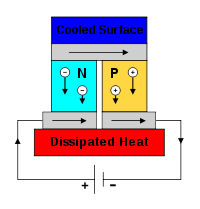
Thermoelectric Cooler
Over the past few years, I have managed to wear out three conventional dehumidifiers. By conventional, I merely refer to their used of heat pumps employing the vaporisation and condensation of a circulating fluid.
I’m not complaining (much) as they all had a pretty hard time, dealing with various leaking roofs and permanently damp areas around my house.
Notably, they all died for much the same reason, having lost gas over the years, none of them could be easily recharged as none of them were fitted with valves to allow the refrigerant to be topped up. These units are factory charged, and the ports are brazed to seal them forever once the job is done.
If I had a gripe, it would be about the quality of manufacture, which deteriorated markedly with each replacement, as each newer item (all similarly specified) lasted only about half as long as its predecessor, before the fans (bearings – “sealed for life”) started to play up, and the chillers chilled less and less as time passed.
With the rising cost of electricity, and these things running almost constantly and drawing around 300 W, when the last one gave up, I decided not to replace it.
However, I did still have one damp problem that was not easily fixed or prevented, and remains a nuisance.
Peltier effect
In plain English, a Peltier junction is a semiconductor that get hot on one side and cold on the other when voltage is applied and current flows through it. So, it acts as a heat pump, or a thermoelectric cooler, moving heat (energy) from one side to the other. There’s no motors, pumps, fluid, oils, or gases involved, so it’s quite efficient. Missing all the hardware – apart from a fan to move air over the junction – it’s also a lot quieter than compressor units.
They’ve been around for a while in the domestic market, and I have a handy cool box (portable battery operated fridge) that used the same device, and it works really well. My only grip is having to keep it running all the time, as the insulation used around the box is rubbish to say the least, and if not powered, it heat up to ambient a lot quicker than a conventional cool box.
Peltier dehumidifier

Still with a condensation problem to address, and not wanting to part with yet another £200 or so for an ordinary dehum(idifier) (which I reckoned would die even faster than its cousins), our local emporium had some ‘new’ Peltier dehums on offer for £50, so I thought it worth a try.
Drawing only 60 W and claiming only 600 ml collection per day (conventional claimed 300 W and 5 litres per day) the numbers seemed reasonable.
Sad to say, the reality has not been anywhere close.
In fact, having run the new dehum under various ambient temperatures and humidity levels, it barely manages to fill its little 600 ml tank in a week, let alone a day.
Having pulled it apart, the design just seems to lack efficiency.
The compressor types have a real heat exchanger matrices with large areas and close coupling to the chiller.
The Peltier has no such matrix, with only a solid aluminium heatsink with a few heavy fins which the air is channelled through.
At a guess, if the areas of the exchanger could be increased, and was better coupled to the junction, the more air could be treated, and more moisture could be condensed, extracted. As it is, the transit time of the air passing over the chiller is just too short for effective condensation to take place, and the air leave the dehum much as was when it arrived.
More, and thinner, fins are needed as far as I can see.
If only I had the tools to make something to try this.
How bad?

I had an example of just how poor this dehum works this week, when the sudden heavy rain that arrived at the start of the week revealed a failure in my flat garage roof, and the water started coming in through one corner.
This soaked the floor, and takes 2-3 days to dry itself out if I leave it.
I sat the Peltier dehum in the middle of the damp patch.
Yep… it was 3 days before the floor dried out, just the same as if there had been no dehum eating 60 W, and the dehum reservoir barely collected 100 ml in that time.
Somewhat short of claimed 600 ml per day, or even 100 ml per day. Remember, my compressor dehums did manage their claimed collection rate, when new.
Now for the fun fact of the day – I saw the same dehum for sale for £30 more than I paid in our local electronic specialists, but rated at 1,200 ml per day. I thought it might have had two junctions built-in (even though there is insufficient space), but when I got my hands on this “super” dehum and read the label, it was still just rated at 12 V and 5 A, and that’s still just 60 W. Same as mine, which barely makes 50 ml on a good day.
They do work, but just do it so incredibly slowly.
I can do better with a mop. bucket, sponge, and cloths!
CC cooler image by Ken Brazier via Wikimedia Commons.
